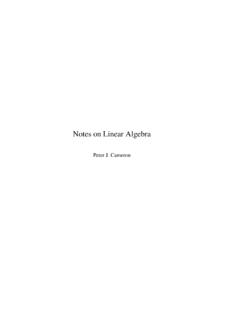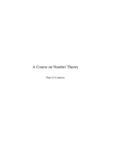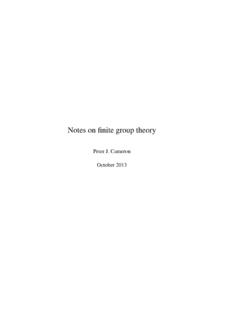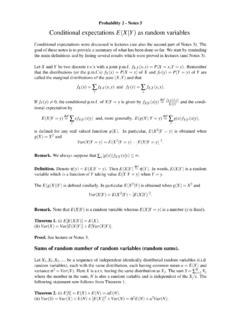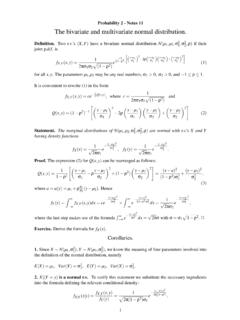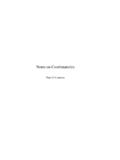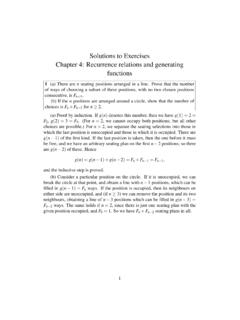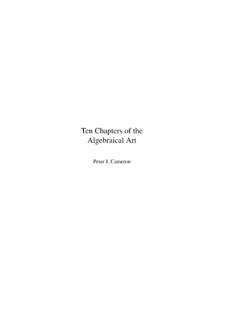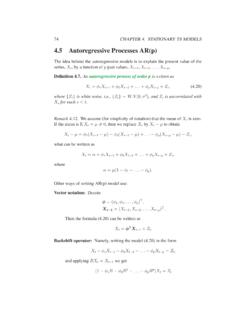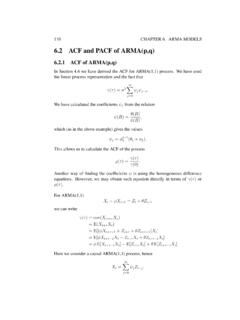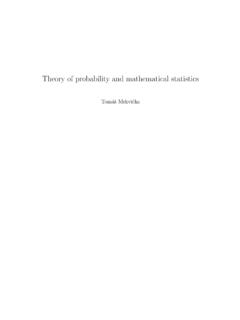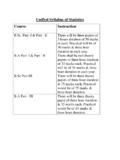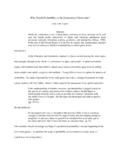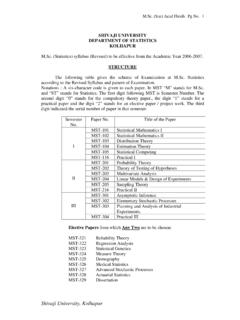Transcription of Notes on Probability - School of Mathematical …
1 Notes on Probability Peter J. Cameron ii Preface Here are the course lecture Notes for the course MAS108, Probability I, at Queen Mary, University of London, taken by most Mathematics students and some others in the first semester. The description of the course is as follows: This course introduces the basic notions of Probability theory and de- velops them to the stage where one can begin to use probabilistic ideas in statistical inference and modelling, and the study of stochastic processes. Probability axioms. Conditional Probability and indepen- dence. Discrete random variables and their distributions. Continuous distributions.
2 Joint distributions. Independence. Expectations. Mean, variance, covariance, correlation. Limiting distributions. The syllabus is as follows: 1. Basic notions of Probability . Sample spaces, events, relative frequency, Probability axioms. 2. Finite sample spaces. Methods of enumeration. Combinatorial Probability . 3. Conditional Probability . Theorem of total Probability . Bayes theorem. 4. Independence of two events. Mutual independence of n events. Sampling with and without replacement. 5. Random variables. Univariate distributions - discrete, continuous, mixed. Standard distributions - hypergeometric, binomial, geometric, Poisson, uni- form, normal, exponential.
3 Probability mass function, density function, dis- tribution function. Probabilities of events in terms of random variables. 6. Transformations of a single random variable. Mean, variance, median, quantiles. 7. Joint distribution of two random variables. Marginal and conditional distri- butions. Independence. iii iv 8. Covariance, correlation. Means and variances of linear functions of random variables. 9. Limiting distributions in the Binomial case. These course Notes explain the naterial in the syllabus. They have been field- tested on the class of 2000. Many of the examples are taken from the course homework sheets or past exam papers.
4 Set books The Notes cover only material in the Probability I course. The text- books listed below will be useful for other courses on Probability and statistics. You need at most one of the three textbooks listed below, but you will need the statistical tables. Probability and Statistics for Engineering and the Sciences by Jay L. De- vore (fifth edition), published by Wadsworth. Chapters 2 5 of this book are very close to the material in the Notes , both in order and notation. However, the lectures go into more detail at several points, especially proofs. If you find the course difficult then you are advised to buy this book, read the corresponding sections straight after the lectures, and do extra exercises from it.
5 Other books which you can use instead are: Probability and Statistics in Engineering and Management Science by W. W. Hines and D. C. Montgomery, published by Wiley, Chapters 2 8. Mathematical Statistics and Data Analysis by John A. Rice, published by Wadsworth, Chapters 1 4. You should also buy a copy of New Cambridge Statistical Tables by D. V. Lindley and W. F. Scott, pub- lished by Cambridge University Press. You need to become familiar with the tables in this book, which will be provided for you in examinations. All of these books will also be useful to you in the courses Statistics I and Statistical Inference.
6 The next book is not compulsory but introduces the ideas in a friendly way: Taking Chances: Winning with Probability , by John Haigh, published by Oxford University Press. v Web resources Course material for the MAS108 course is kept on the Web at the address pjc/MAS108/. This includes a preliminary version of these Notes , together with coursework sheets, test and past exam papers, and some solutions. Other web pages of interest include chance/teaching aids/. books articles/ Probability A textbook Introduction to Probability , by Charles M. Grinstead and J. Laurie Snell, available free, with many exercises. The Virtual Laboratories in Probability and Statistics, a set of web-based resources for students and teachers of Probability and statistics, where you can run simula- tions etc.
7 The Birthday Paradox (poster in the London Underground, July 2000). An article on Venn diagrams by Frank Ruskey, with history and many nice pic- tures. Web pages for other Queen Mary maths courses can be found from the on-line version of the Maths Undergraduate Handbook. Peter J. Cameron December 2000. vi Contents 1 Basic ideas 1. Sample space, events .. 1. What is Probability ? .. 3. Kolmogorov's Axioms .. 3. Proving things from the axioms .. 4. Inclusion-Exclusion Principle .. 6. Other results about sets .. 7. Sampling .. 8. Stopping rules .. 12. Questionnaire results .. 13. Independence .. 14. Mutual independence.
8 16. Properties of independence .. 17. Worked examples .. 20. 2 Conditional Probability 23. What is conditional Probability ? .. 23. Genetics .. 25. The Theorem of Total Probability .. 26. Sampling revisited .. 28. Bayes' Theorem .. 29. Iterated conditional Probability .. 31. Worked examples .. 34. 3 Random variables 39. What are random variables? .. 39. Probability mass function .. 40. Expected value and variance .. 41. Joint of two random variables .. 43. Some discrete random variables .. 47. Continuous random variables .. 55. vii viii CONTENTS. Median, quartiles, percentiles .. 57. Some continuous random variables.
9 58. On using tables .. 61. Worked examples .. 63. 4 More on joint distribution 67. Covariance and correlation .. 67. Conditional random variables .. 70. Joint distribution of continuous .. 73. Transformation of random variables .. 74. Worked examples .. 77. A Mathematical notation 79. B Probability and random variables 83. Chapter 1. Basic ideas In this chapter, we don't really answer the question What is Probability ?' No- body has a really good answer to this question. We take a Mathematical approach, writing down some basic axioms which Probability must satisfy, and making de- ductions from these. We also look at different kinds of sampling, and examine what it means for events to be independent.
10 Sample space, events The general setting is: We perform an experiment which can have a number of different outcomes. The sample space is the set of all possible outcomes of the experiment. We usually call it S . It is important to be able to list the outcomes clearly. For example, if I plant ten bean seeds and count the number that germinate, the sample space is S = {0, 1, 2, 3, 4, 5, 6, 7, 8, 9, 10}. If I toss a coin three times and record the result, the sample space is S = {HHH, HHT, HT H, HT T, T HH, T HT, T T H, T T T }, where (for example) HT H means heads on the first toss, then tails, then heads again'. Sometimes we can assume that all the outcomes are equally likely.
